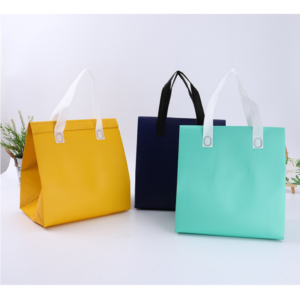Meltblown nonwoven fabric is widely used in the production of wipes and cleaning products due to its unique properties.
Here are some applications of meltblown nonwoven fabric in this industry:
Wet Wipes: Meltblown nonwoven fabric is commonly used as the absorbent core in wet wipes. It has excellent liquid absorption capacity, allowing the wipes to effectively absorb and retain liquids such as water, cleaning solutions, or disinfectants.
Dry Wipes: Meltblown nonwoven fabric is also used in the production of dry wipes, which are used for dusting, polishing, or general cleaning purposes. The fabric’s softness, high surface area, and ability to trap dirt particles make it suitable for dry wiping applications.
Household Cleaning Products: Meltblown nonwoven fabric is integrated into various household cleaning products such as dusting cloths, kitchen wipes, and multipurpose cleaning wipes. Its absorbency and ability to pick up dirt and debris make it an effective material for these applications.
Industrial and Automotive Cleaning: Meltblown nonwoven fabric is used in industrial and automotive cleaning products, including surface cleaning wipes, degreasing wipes, and oil-absorbent wipes. Its strength, absorbency, and resistance to chemicals make it suitable for heavy-duty cleaning tasks.
Personal Care Wipes: Meltblown nonwoven fabric is utilized in personal care wipes, such as facial wipes, baby wipes, and hygiene wipes. The fabric’s softness, gentleness on the skin, and ability to hold lotions or creams make it ideal for these applications.
Healthcare and Medical Wipes: Meltblown nonwoven fabric is used in healthcare and medical settings for various wipes, including disinfectant wipes, patient cleansing wipes, and wound cleansing wipes. The fabric’s high absorbency, softness, and compatibility with disinfectants make it valuable in these critical environments.
Food Service Wipes: Meltblown nonwoven fabric is employed in food service wipes for tasks like surface sanitization, food preparation, and spill cleanup. The fabric’s ability to absorb liquids, remove contaminants, and maintain hygiene standards is essential in the food industry.
Electronics and Optics Cleaning: Meltblown nonwoven fabric is used in wipes designed for cleaning delicate electronics, optical lenses, and screens. The fabric’s low linting properties, soft texture, and ability to trap dust particles without scratching surfaces make it suitable for these sensitive applications.
These are some of the applications of meltblown nonwoven fabric in the production of wipes and cleaning products. The fabric’s absorbency, softness, strength, and compatibility with various cleaning agents contribute to its effectiveness in these applications.
How does meltblown nonwoven fabric contribute to the absorption and retention of liquid in hygiene products?
Meltblown nonwoven fabric plays a crucial role in the absorption and retention of liquid in hygiene products.
Here’s how it contributes to these properties:
Fine Fiber Structure: Meltblown nonwoven fabric is manufactured using a process that creates a web of fine fibers with a high surface area. The fine fiber structure allows for efficient liquid absorption and retention.
Capillary Action: The fine fibers in meltblown nonwoven fabric create capillary channels that enable liquid to be drawn into the fabric. meltblown nonwoven fabric Capillary action helps distribute the liquid throughout the fabric quickly, enhancing absorption.
Absorption Capacity: Meltblown nonwoven fabric has excellent absorption capacity due to its high surface area and porosity. The fabric can absorb liquid rapidly, preventing it from pooling on the surface and improving the product’s efficiency.
Liquid Retention: Once absorbed, meltblown nonwoven fabric effectively retains the liquid within its structure. The fine fibers and interlocking network help trap and hold the liquid, preventing immediate re-release.
Fluid Distribution: Meltblown nonwoven fabric facilitates even distribution of the absorbed liquid within the product. This feature ensures that the liquid is spread uniformly throughout the fabric, maximizing the product’s effectiveness.
Quick Drying: Meltblown nonwoven fabric has good moisture management properties, allowing for rapid evaporation of absorbed liquids. This quick-drying characteristic helps maintain a dry and comfortable surface, reducing the risk of moisture-related issues.
Softness and Comfort: Meltblown nonwoven fabric is known for its soft and gentle texture, making it suitable for hygiene products. The fabric’s softness enhances user comfort while maintaining efficient liquid absorption and retention.
Compatibility with Lotions and Creams: Meltblown nonwoven fabric is often used in hygiene products that incorporate lotions, creams, or other liquid formulations. The fabric’s structure allows it to hold these substances effectively, ensuring their proper distribution during use.
Overall, the structure, porosity, and absorbent properties of meltblown nonwoven fabric contribute to its ability to efficiently absorb and retain liquids in hygiene products. These characteristics enhance the performance, comfort, and user experience of various personal care and hygiene items.
